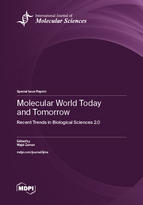Molecular World Today and Tomorrow: Recent Trends in Biological Sciences 2.0
A special issue of International Journal of Molecular Sciences (ISSN 1422-0067). This special issue belongs to the section "Molecular Biology".
Deadline for manuscript submissions: closed (30 November 2023) | Viewed by 31177
Special Issue Editor
Interests: plant systematics; medicinal plants; plant biodiversity; phylogenetics
Special Issues, Collections and Topics in MDPI journals
Special Issue Information
Dear Colleagues,
This Special Issue is supervised by Dr. Wajid Zaman and assisted by our Topical Advisory Panel Member Dr. Hakim Manghwar (Chinese Academy of Sciences).
Various molecular techniques based on omics (transcriptomics, proteomics, genomics) and phylogenetics have been applied in biological sciences. Molecular dynamics and approaches evolved over time into various quantitative tools that allow researchers from multiple disciplines to design different studies. The molecular-based techniques can be comprehensive and systematic, as they allow identification, resolve genetic differences, molecular docking, and prediction models of ecological niches and taxonomic ranks. Investigating genomics, proteomics, and phylogenetic techniques utilize a novel class of DNA elements such as microsatellites from mitochondria and chloroplast and retrotransposons, resulting in genetic variations using molecular data. Besides this, the advantages and limitations of molecular approaches have been well studied and acknowledged. The combination of molecular phylogenetic and omics techniques and expression and pathways analysis may greatly increase our capacity to understand and develop new molecular mechanisms and stress responses in biological systems. Furthermore, these techniques offer extensive opportunities for researchers to develop targeted therapy approaches and disease diagnoses using molecular data. It is necessary to evaluate and explore how data from diverse molecular techniques can be applied to different biological studies. The study and applications of molecular approaches hold significant potential for advancing genomics, proteomics, and phylogenetic techniques in biological sciences.
Dr. Wajid Zaman
Guest Editor
Manuscript Submission Information
Manuscripts should be submitted online at www.mdpi.com by registering and logging in to this website. Once you are registered, click here to go to the submission form. Manuscripts can be submitted until the deadline. All submissions that pass pre-check are peer-reviewed. Accepted papers will be published continuously in the journal (as soon as accepted) and will be listed together on the special issue website. Research articles, review articles as well as short communications are invited. For planned papers, a title and short abstract (about 100 words) can be sent to the Editorial Office for announcement on this website.
Submitted manuscripts should not have been published previously, nor be under consideration for publication elsewhere (except conference proceedings papers). All manuscripts are thoroughly refereed through a single-blind peer-review process. A guide for authors and other relevant information for submission of manuscripts is available on the Instructions for Authors page. International Journal of Molecular Sciences is an international peer-reviewed open access semimonthly journal published by MDPI.
Please visit the Instructions for Authors page before submitting a manuscript. There is an Article Processing Charge (APC) for publication in this open access journal. For details about the APC please see here. Submitted papers should be well formatted and use good English. Authors may use MDPI's English editing service prior to publication or during author revisions.
Keywords
- molecular techniques
- phylogenetics
- transcriptomics
- proteomics
- genomics
- biological sciences
- gene expression







